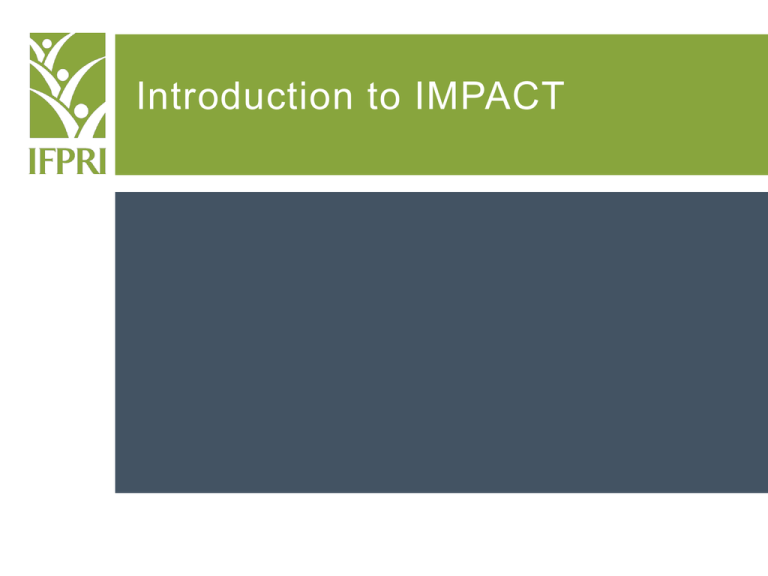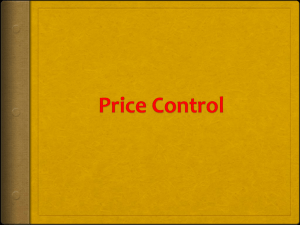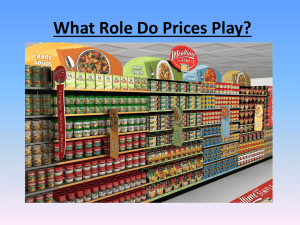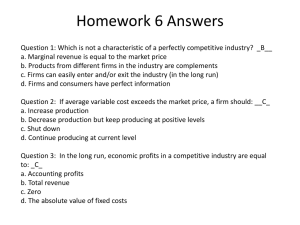Introduction to IMPACT Economics
advertisement

Introduction to IMPACT Models • Models are logical constructs that represent systems • Models can: – Simplify a complex system – Provide insights to the inner workings of a system • Models cannot explain everything Model Vocabulary • Agents: Actors within the system (consumers, farmers, governments) • Variables: Conditions defining the state of the agents (income, farmland, technology) – Exogenous Variables: Inputs to the model, defined by the designer (population, income) – Endogenous Variables: Outputs of the model (food demand, commodity prices) • Assumptions: Rules about interactions between agents and variables (equilibrium, max climate change yield reductions) Economics • Study of the allocation of scarce resources • There are many allocation methods • In Trade Theory the market is predominant – A market is the process of negotiation between buyers and sellers, which determines the prices for goods and services Economic Trade Models • Many types of trade = Many trade models • Defining Model Scope – – – – What is traded (general vs. partial equilibrium) Who are the agents (micro vs. macro) Market location (local, regional, global) Types of analysis (normative or positive) • IMPACT’s scope: – – – – Partial equilibrium focused on Ag. Sector Macro Agents Global markets Both normative and positive analysis Defining IMPACT: Agents • 159 geopolitical regional governments • Consumers are region level agents and are defined as either urban or rural • Farmers are FPU-level agents and are defined by production technology (irrigated, rainfed, etc.) – FPUs (Food production units) are subnational geospatial units Defining IMPACT: Exogenous Variables • Socio-demographic change (Population, GDP) • Consumer and producer preferences (elasticities) • Productivity and technology change (IPRs) • Climate change and yield response • Starting Point (base values) and time horizon Defining IMPACT: Endogenous Variables • Agriculture Sector Projections for: – Commodity Prices – Commodity Production and Demand – Crop Areas and Yields – Food Availability Defining IMPACT: Assumptions • Equilibrium (supply=demand) • Demand is a function of consumer preferences, commodity prices, and budgetary constraints • Supply is derived from area-yield functions and is a function of existing land, crop prices, changes in technology, and the availability and cost of inputs • Suppliers are profit maximizers and consumers are utility mazimizers Explaining Demand • The products and services consumed at a given price Explaining Demand Deriving the Demand Curve QTea PCoffee • The products and services consumed at a given price • Consumers face budgetary constraints QCoffee QCoffee Explaining Demand – Must make trade offs based on preferences (elasticity) Inelastic Demand Deriving the Demand Curve QTea PCoffee • The products and services consumed at a given price • Consumers face budgetary constraints QCoffee Elastic Demand Price Price QCoffee Quantity Quantity Explaining Supply • The products and services supplied at a given price Simplified Supply Curve Price Quantity Explaining Supply • The products and services supplied at a given price • Suppliers must determine how to best utilize inputs for profit maximization. Simplified Supply Curve Price Quantity Maize Wheat Explaining Supply • The products and services supplied at a given price • Suppliers must determine how to best utilize inputs for profit maximization. – Production Possibility Frontier – Set of possible outputs from available inputs and technology Maize Maize Wheat Maize Wheat Better Wheat Fertilizers Wheat More Arable Land Explaining the Market • Markets are where consumers and producers negotiate prices. Prices will fluctuate until equilibrium is reached (supply=demand) • Why assume equilibrium? Simplified Supply Curve – What happens at price P2? P S P2 - Consumers want Q1 - Producers produce Q2 - There is a surplus of Q2Q1 P0 P1 D Q1 Q0 Q2 Q Explaining the Market • Markets are where consumers and producers negotiate prices. Prices will fluctuate until equilibrium is reached (supply=demand) • Why assume equilibrium? – What happens at price P2? Curve Simplified Supply P S P2 P0 P1 - Consumers want Q1 - Producers produce Q2 - There is a surplus of Q2Q1 - Producers will have to lower prices to sell excess production D Q1 Q0 Q2 Q Explaining the Market • Markets are where consumers and producers negotiate prices. Prices will fluctuate until equilibrium is reached (supply=demand) • Why assume equilibrium? – What happens at price P2? Curve Simplified Supply P S P2 P0 P1 - Consumers want Q1 - Producers produce Q2 - There is a surplus of Q2Q1 - Producers will have to lower prices to sell excess production D Q1 Q0 Q2 Q Explaining the Market • Markets are where consumers and producers negotiate prices. Prices will fluctuate until equilibrium is reached (supply=demand) • Why assume equilibrium? Simplified Supply – What happens at price P1? Curve P S P2 P0 P1 - Consumers want Q2 - Producers will produce Q1 - There is now a shortage Q2-Q1 D Q1 Q0 Q2 Q Explaining the Market • Markets are where consumers and producers negotiate prices. Prices will fluctuate until equilibrium is reached (supply=demand) • Why assume equilibrium? Simplified Supply – What happens at price P1? Curve P S P2 P0 P1 D Q1 Q0 Q2 - Consumers want Q2 - Producers will produce Q1 - There is now a shortage Q2-Q1 - Excess demand will push prices up till production meets Q demand Explaining the Market • Markets are where consumers and producers negotiate prices. Prices will fluctuate until equilibrium is reached (supply=demand) • Why assume equilibrium? Simplified Supply Curve – What happens at price P1? P S P2 P0 P1 D Q1 Q0 Q2 - Consumers want Q2 - Producers will produce Q1 - There is now a shortage Q2-Q1 - Excess demand will push prices up till production meets Q demand Activity-Commodity Framework • IMPACT 3 is a structural model – Describes the production process in a reduce form • Activities – Represent production processes • Farms, ranches, processing plants – Demand factors of production – Produce commodities 22 Activity-Commodity Framework • Commodities are: – Produced – Traded – Consumed – Can be endogenous or exogenous • Maize has endogenous production and demand • Oilseeds have endogenous production and both endogenous and exogenous demand (biofuels) • Fertilizers could be considered an exogenous commodity 23 Crop Example Activity • Soybean Farm (jsoyb) • Demands land, fertilizer, labor Activity Output • Soybean Commodity (csoyb) 24 Processed Commodity Example Activity • Soybean Processing (jsbol) • Demands soybeans (csoyb) at market price Processed Commodities • Soybean Oil (csbol) • Soybean Meal (csbml) 25 Complete Oilseed ActivityCommodity Chain Activity • Soybean Farm (jsoyb) • Demands land, fertilizer, labor Activity Output • Soybean Commodity (csoyb) Activity • Soybean Processing (jsbol) • Demands soybeans (csoyb) at market price Processed Commodities • Soybean Oil (csbol) • Soybean Meal (csbml) IMPACT Prices • Prices are Endogenous – Ensure Global Supply = Global Demand • Each country has three markets: – Farm gate – National – International • Price wedges (marketing margins, taxes, subsidies) between markets 27 Producer Prices Producer Price • Price at Farm/Factory Gate • 𝑃𝑃 = 1 + 𝑃𝑆𝐸 × 𝐼𝑛𝑝𝑢𝑡𝑠 𝑃𝐶 • Prices that are paid by traders for activity outputs – Price at farm or factory gate • Equal to the sum of input costs of an activity and any ad valorem producer subsidy (PSE) – PSEs originally are from OECD sources and have been adjusted and mapped to IMPACT countries and activities 28 Consumer Prices Producer Price Marketing Margin • Price at Farm/Factory Gate • 𝑃𝑃 = 1 + 𝑃𝑆𝐸 × 𝐼𝑛𝑝𝑢𝑡𝑠 𝑃𝐶 Consumer Price • Commodity prices consumers face • Prices consumers pay in national markets for commodities – Includes transportation costs, as well as taxes and tariffs • Consumer Subsidies are targeted and applied in the demand equations 29 Consumer Prices Producer Price • Price at Farm/Factory Gate • 𝑃𝑃 = 1 + 𝑃𝑆𝐸 × 𝐼𝑛𝑝𝑢𝑡𝑠 𝑃𝐶 Consumer Price Marketing Margin • Commodity prices consumers face • 𝑃𝐶 = 𝑃𝑊 × (1 + 𝑡) × (1 + 𝑀𝑀) Marketing Margin Trade Regime World Price 30 Consumer Prices • Consumer prices are set to either the country’s export price or its import price To trade or not to trade? – 𝑃𝐶 = 𝑃𝑊 × (1 + 𝑡) × (1 + 𝑀𝑀) • This switch allows commodities to change from globally traded to non-traded endogenously 31 Tradability in IMPACT • Commodities can be globally traded or non-traded • This option can be set exogenously Export Price Import Price 𝑃𝐸 = 𝑃𝑊 × (1 𝑃𝑀 = 𝑃𝑊 × (1 – E.g. sugar beets • Or endogenously through the following inequality P E < P C < P M 32








